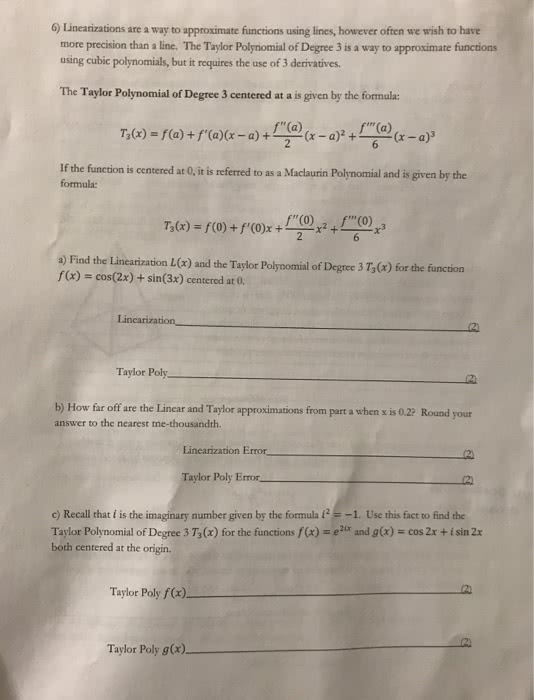MAT 21C Lecture 11: MAT 21C – Lecture 11 – Taylor Series and Remainder Theorem

MAT 21C – Lecture 11 – Taylor Series and Remainder Theorem
• A Taylor series can be described with a function, f(x) with derivatives of all
orders. The nth Taylor coefficient of f(x) at x = a is
• The Taylor series of f(x) at x = a is
. The Taylor polynomial of
degree n of f(x) at x = a is
• The question is how well does approximate f(x) when x is close to a?
• Example: Consider the Taylor Series at x = 0 for f(x) = sin(x). Approximate sin(0.1)
and sin(1) using Taylor polynomials.
n
0
sin(x)
f(0) = 0
1
cos(x)
f’ =
2
-sin(x)
f’’ =
3
-cos(x)
f’’’ = -1
4
sin(x)
5
cos(x)
6
-sin(x)
7
-cos(x)
The Taylor series of the 7th order is
The Taylor polynomial of degree 2n + 1 is
. Taylor coefficients are
;
If x = 0.1, then
and
The actual value of
sin. = .…
If x = 1, then
and
The actual value of sin = .…
• Taylor’s Theore with Reaider:
for some
find more resources at oneclass.com
find more resources at oneclass.com

52
MAT 21C Full Course Notes
Verified Note
52 documents
Document Summary
Mat 21c lecture 11 taylor series and remainder theorem n sin(x) cos(x) sin(x) cos(x) The nth taylor coefficient of f(x) at x = a is (cid:1855)=(cid:4666)(cid:4667): the taylor series of f(x) at x = a is (cid:4666) (cid:4667). =(cid:2868) (cid:4666) (cid:4667)=(cid:1858)(cid:4666)(cid:4667)+ (cid:1858) (cid:4666)(cid:4667)(cid:4666) degree n of f(x) at x = a is (cid:4666)(cid:4667)= (cid:4666)(cid:4667)! =(cid:2868) (cid:4667)+ (cid:2869)(cid:2870)!(cid:1858) (cid:4666)(cid:4667)(cid:4666) (cid:4667)(cid:2870)+ +(cid:2869)! (cid:1858)(cid:4666)(cid:4667)(cid:4666) (cid:4667: the question is how well does (cid:4666)(cid:4667) approximate f(x) when x is close to a? (cid:1858)(cid:4666)(cid:882)(cid:4667) (cid:1858)(cid:4666)(cid:4667) (cid:1858)(cid:2872)(cid:4666)(cid:882)(cid:4667)=(cid:882) (cid:1858)(cid:2873)(cid:4666)(cid:882)(cid:4667)=(cid:883) (cid:1858)(cid:2874)(cid:4666)(cid:882)(cid:4667)=(cid:882) (cid:1858)(cid:2875)(cid:4666)(cid:882)(cid:4667)= (cid:883) The taylor series of the 7th order is (cid:2869)(cid:2871)!(cid:2871)+ (cid:2869)(cid:2873)!(cid:2873)+(cid:2869)(cid:2875)! (cid:2875)+ . The taylor polynomial of degree 2n + 1 is (cid:4666)(cid:4667)= (cid:2869)(cid:2871)!(cid:2871)+(cid:2869)(cid:2873)!(cid:2873) (cid:2869)(cid:2875)! (cid:2875)+ If x = 0. 1, then (cid:2869)(cid:4666)(cid:882). (cid:883)(cid:4667)=(cid:882). (cid:883); (cid:2871)(cid:4666)(cid:882). (cid:883)(cid:4667)=(cid:882). (cid:883) (cid:2869)(cid:2871)!(cid:4666)(cid:882). (cid:883)(cid:4667)(cid:2871)=(cid:882). (cid:882)(cid:891)(cid:891)(cid:890)(cid:885)(cid:885)(cid:885) and (cid:2873)(cid:4666)(cid:882). (cid:883)(cid:4667)=(cid:882). (cid:883) (cid:2869)(cid:2871)!(cid:4666)(cid:882). (cid:883)(cid:4667)(cid:2871)+(cid:2869)(cid:2873)!(cid:4666)(cid:882). (cid:883)(cid:4667)(cid:2873)=(cid:882). (cid:882)(cid:891)(cid:891)(cid:890)(cid:885)(cid:885)(cid:886)(cid:883)(cid:888)(cid:888)(cid:888) the actual value of. If x = 1, then (cid:2869)(cid:4666)(cid:883)(cid:4667)=(cid:883); (cid:2871)(cid:4666)(cid:883)(cid:4667)=(cid:883) (cid:2869)(cid:2871)!(cid:4666)(cid:883)(cid:4667)(cid:2871)=(cid:882). (cid:890)(cid:885)(cid:885)(cid:885)(cid:885)(cid:885)(cid:885) and (cid:2873)(cid:4666)(cid:883)(cid:4667)=(cid:883) (cid:2869)(cid:2871)!(cid:4666)(cid:883)(cid:4667)(cid:2871)+(cid:2869)(cid:2873)!(cid:4666)(cid:883)(cid:4667)(cid:2873)=(cid:882). (cid:890)(cid:886)(cid:883)(cid:888)(cid:888)(cid:888)(cid:888)(cid:888)(cid:888) .




